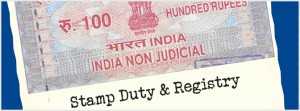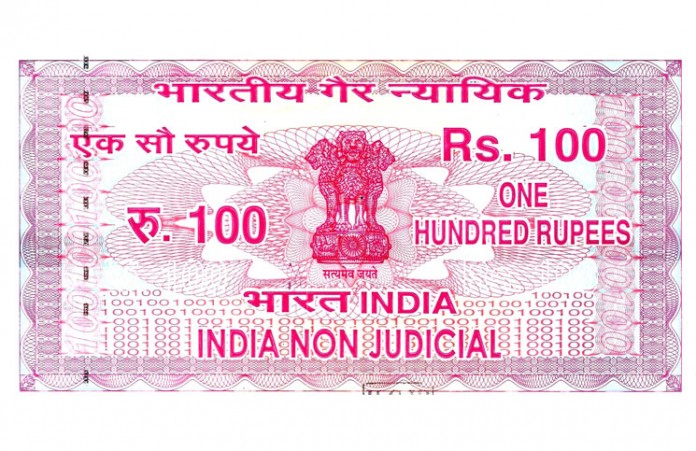What is Stamp duty and what are the types of stamp duty. Read further to know more about it as Suchismita Bose in II Yr of Ram Manohar Lohiya National Law University elaborates.
What is Stamp Duty?
‘Stamp duty’ means a tax payable on certain legal documents specified by statute; the duty may be fixed or ad valorem meaning that the tax paid as a stamp duty may be a fixed amount or an amount which varies based on the value of the products, services or property on which it is levied. It is basically a kind of tax paid on any transaction based on exchange of documents or execution of instruments.

What is the difference between a document and an instrument?
A document is the record of the conditions agreed upon by the parties involved in a transaction in a proper format. A document whose stamp duty has been paid or more simply, a stamped document is considered an authentic and legal document. It gets evidentiary value and can be admitted as evidence in Courts under the provisions of the Indian Stamp Act, 1899. The Indian Stamp Act, 1899 is a fiscal statute dealing with tax on transaction.
Instrument is a document by which a right or liability is created, transferred, extended, limited, extinguished or recorded.
Coming to the subject of stamps used on these documents, in India, two types of stamps are used:
Impressed stamp
Adhesive stamp
Impressed stamps can be:
-
- 1. Labels affixed and impressed by proper officer,
-
- 2. Stamps embossed or engraved on stamp paper, and
- 3. Impressions by franking machines generally done by the bank by depositing the necessary amount of stamp duty with the banks.
Adhesive stamps can be:
Adhesive stamps are labels which can be conveniently stuck on the instruments. Adhesive stamps can be further categorised into two categories: postal and non-postal stamps. Postal stamps are used only for transaction with the post office and related function whereas a non-postal stamp can be a court fee stamp, revenue stamp, notarial stamp, special adhesive stamp, foreign bill stamp, brokers’ note, insurance policy stamp or a share transfer stamp.
The most important aspect of the stamp duty is the calculation of the stamp duty. But before the procedure of calculation itself, some basics need to be cleared.
On what kind of documents is a stamp duty levied on?
Stamp Duty, in India, is generally levied on transfer of property, shares, debentures, bill of exchange, conveyance deed, hire purchase, promissory note and movable and immovable assets. It is also used for partnership deed, gift deed, lease agreement, rent agreement, increase in authorized capital, agreement of sale, buying a house, bank guarantee, commercial property, home loan, loan agreement, mortgage, and service apartment. In real estate transaction that involves buying, selling, renting, and leasing of a residential or commercial property, stamp duty of required value are paid before signing it as the documents are not producible in a Court unless properly stamped.
Stamp Duty Calculator:
Usually it is easy enough to calculate the stamp duty payable as per the rates provided in the Indian Stamp Act or the State Stamp Act and pay accordingly. But in complex cases, the person paying the duty may not be able to ascertain the correct stamp duty and may for help apply for the opinion of the Collector of Stamps.
First step to calculate the Stamp duty is to identify which category the document or instrument falls under. There are three categories of transaction for the purpose of stamp duty calculation:
Under the first category, the stamp duty remains fixed no matter what value is mentioned in the document or instrument. Examples of such instruments are Administration Bond, Affidavit, Adoption Deed, Appointment in Execution of Power, Divorce, Apprenticeship Deed, Award, Article of Clerkship, Cancellation Deed, Duplicate, Charter Party, Copy of Extracts, Indemnity Bond, Power of Attorney, etc.
Under the second category, Stamp duty charges are dependent upon the value mentioned in the document. Such documents are Mortgage Deed, Lease Agreement, Title Deeds, Security Bond, Hypothecation Deed, Article of Association, etc.
Under the third category, the Stamp duty depend either on the value mentioned in the document or on the true market value, whichever is higher. Instruments like Conveyance, Agreement for sale, Gift exchange, Partnership Deed, Development Agreement, Transfer of Immovable Property, Trust Deed, Partition, and so on.
Stamp duty for property transactions:
Calculation of Stamp Duty Rates for property transactions:
The stamp duty rate varies from one kind of transaction and on the location of the transaction. Every state in India follows a separate stamp duty rate structure. Usually the duty levied is based on the current market value of the concerned property. The rates are determined at the beginning of every year and made public through the stamp duty ready reckon. The concept of e-stamping has now been introduced by the government which is able to come up with a more accurate value of duty for immovable property. Various popular parameters are taken into account by the e-stamping procedure to calculate the rates of stamp duty in a particular region such as debt and mortgage, distance from conveniences, approach roads, etc.
Revenue Stamp:
It is a tax of Re. 1 in the form of revenue stamp, which should be affixed on receipt for any money or other property, the amount or value of which exceeds Rs. 5000.
Rate of stamp duty:
Stamp duty on non-residential properties whether in a co-operative society or not is at a rate of 5% of the market value. Stamp duty on residential flats in a housing society and building covered under Article 25(d) of Schedule of the Bombay Stamp Act, 1958 attracts concessional rates depending upon its market value as follows:
- i. for up to Rs. 1,00,000 stamp duty is nil,
ii. between Rs. 1,00,001 to Rs, 2,50,000 it is 0.5% of the value,
iii. between Rs. 2,50,001 to Rs. 5,00,000 Stamp duty is Rs. 1,250 +3% of the value above Rs. 2,50,000
iv. Above Rs. 5,00,000 it is Rs. 8,750 + 5% of the value above Rs. 5,00,000.
LawSikho has created a telegram group for exchanging legal knowledge, referrals and various opportunities. You can click on this link and join:
https://t.me/joinchat/J_
 Serato DJ Crack 2025Serato DJ PRO Crack
Serato DJ Crack 2025Serato DJ PRO Crack










 Allow notifications
Allow notifications




Can you please confirm the fact that between any two govt. banks in India, the stamp duty on Indemnity Bond is NIL as per extant guidelines.
Excellant write up
Excellant
Good article. Explained in a lucid manner.Very helpful
What is the stamp duty in case where, suppose, the agreement of sale of an immovable property was made on 2nd April 2014 and the sale deed was executed on 4th september 2014. The rate of stamp duty increased in between this period. which rate will be applicable- the one at the time of agreemnet of sale or the one at the the time of sale deed?
The stamp duty leviable on sale deed as applicable as on the date of registration of the document
keepitup nic & helpful…